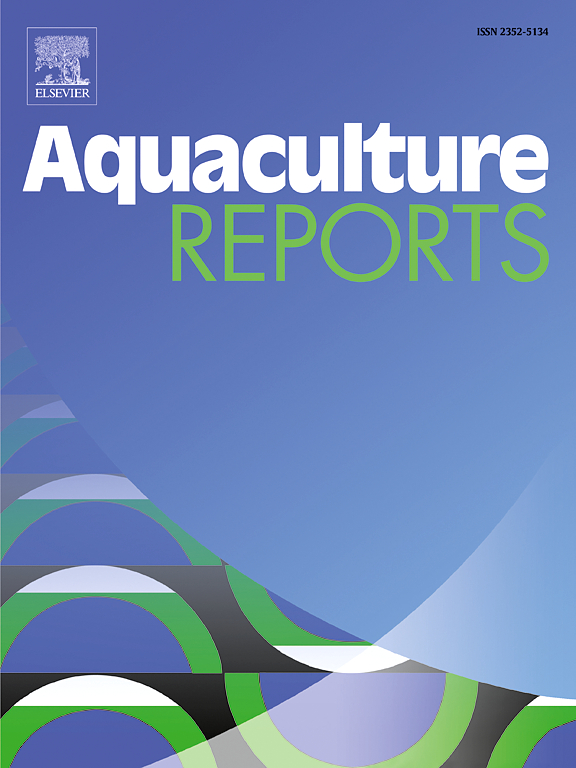Oxygen nanobubble-induced hyperoxia: Effects on growth, digestive enzyme activity, intestinal morphology, and biochemical parameters in kuruma prawn (Penaeus japonicus)
IF 3.7
2区 农林科学
Q1 FISHERIES
引用次数: 0
Abstract
Oxygen nanobubble (NB-O2) technology constitutes an efficient and stable approach for the release of dissolved oxygen (DO), frequently leading to a substantial elevation in DO levels within the water. Nevertheless, the potential effects of long-term hyperoxia induced by NB-O2 exposure in farmed shrimp remain poorly understood. Accordingly, this research aims to investigate the impact of hyperoxia during NB-O2 treatment on growth performance, digestive enzyme activity, intestinal morphology, muscle proximate composition, and target gene expression in kuruma prawn (Penaeus japonicus). The present study employed NB-O2 as a technical strategy to regulate dissolved oxygen levels and conducted a 40-day aquaculture experiment under DO conditions of 7.45 ± 0.16 mg/L (air treatment) and 15.95 ± 0.11 mg/L (NB-O2 treatment). The study demonstrated that hyperoxia during NB-O2 treatment enhances the growth performance of P. japonicus (weight gain rate, specific growth rate, and molting rate), improves intestinal digestive enzyme activity (pepsin, trypsin), and augments muscle proximate components (crude protein, crude fat). Furthermore, the NB-O2 treatment increased serum biochemical parameters (glucose, total protein, albumin, acid phosphatase, alkaline phosphatase, and lysozyme) and upregulated the expression of digestion and antioxidant genes (trypsin 1, peroxidase), and it significantly reduced the number of pathogenic microorganisms in seawater, demonstrating its effectiveness in water quality purification. In conclusion, long-term hyperoxia induced by NB-O2 exposure offer potential benefits for the aquaculture of P. japonicus, promoting overall health and stability.
氧纳米泡诱导的高氧:对日本对虾生长、消化酶活性、肠道形态和生化指标的影响
氧纳米泡(NB-O2)技术是释放溶解氧(DO)的一种有效而稳定的方法,经常导致水中DO水平的大幅升高。然而,对养殖虾长期暴露于NB-O2诱导的高氧的潜在影响仍然知之甚少。因此,本研究旨在探讨NB-O2处理过程中高氧对日本对虾生长性能、消化酶活性、肠道形态、肌肉近体组成和靶基因表达的影响。本研究采用NB-O2作为调节溶解氧水平的技术策略,在7.45 ± 0.16 mg/L(空气处理)和15.95 ± 0.11 mg/L (NB-O2处理)的DO条件下进行了为期40天的水产养殖试验。本研究表明,NB-O2处理期间的高氧提高了日本沼虾的生长性能(增重率、特定生长率和换羽率),提高了肠道消化酶活性(胃蛋白酶、胰蛋白酶),增加了肌肉近组分(粗蛋白质、粗脂肪)。此外,NB-O2处理提高了血清生化指标(葡萄糖、总蛋白、白蛋白、酸性磷酸酶、碱性磷酸酶和溶菌酶),上调了消化和抗氧化基因(胰蛋白酶1、过氧化物酶)的表达,显著减少了海水中病原微生物的数量,证明了其对水质净化的有效性。综上所述,长期暴露于NB-O2诱导的高氧对日本沼虾养殖具有潜在的益处,促进了日本沼虾的整体健康和稳定。
本文章由计算机程序翻译,如有差异,请以英文原文为准。
求助全文
约1分钟内获得全文
求助全文
来源期刊

Aquaculture Reports
Agricultural and Biological Sciences-Animal Science and Zoology
CiteScore
5.90
自引率
8.10%
发文量
469
审稿时长
77 days
期刊介绍:
Aquaculture Reports will publish original research papers and reviews documenting outstanding science with a regional context and focus, answering the need for high quality information on novel species, systems and regions in emerging areas of aquaculture research and development, such as integrated multi-trophic aquaculture, urban aquaculture, ornamental, unfed aquaculture, offshore aquaculture and others. Papers having industry research as priority and encompassing product development research or current industry practice are encouraged.
 求助内容:
求助内容: 应助结果提醒方式:
应助结果提醒方式:


